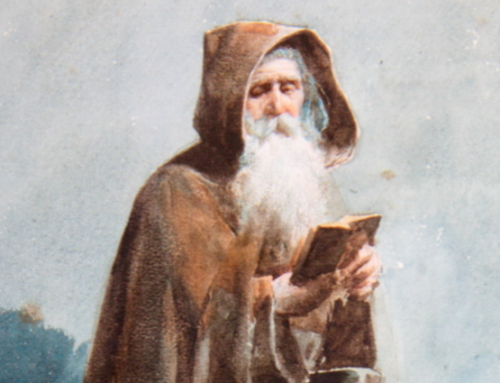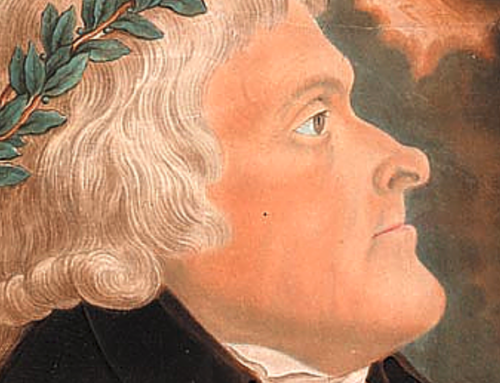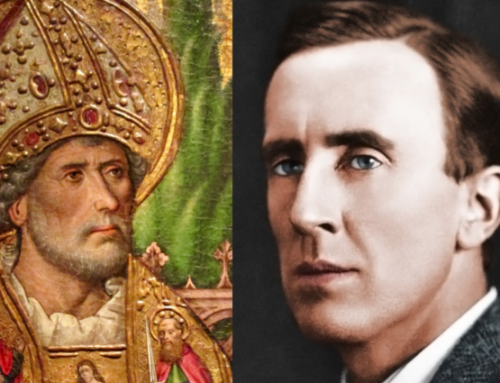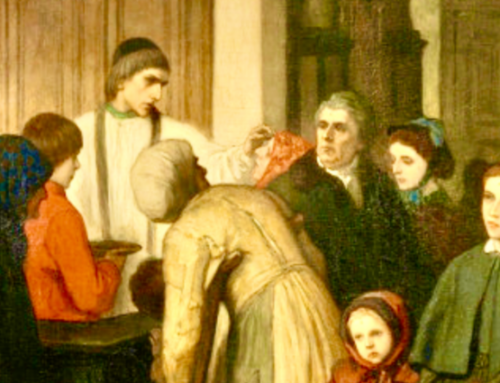If it sounds like an Indiana Jones movie recast with the Sage of Mecosta, you’re not so wrong. It’s a real mystery involving real medieval Crusaders; it’s full of action and adventure, it co-stars the Father of Modern American Conservativism and it may help to explain the Bohemian Tory’s famous wanderlust, imagination and romance. Chuck that trashy Dan Brown novel and bring out the popcorn!
It opens forty years ago on a lonesome country road between Hillsdale College and Dr. Russell Kirk’s ancestral home in Mecosta, Michigan. Your servant was driving as the cigar-smoking sage told gripping tales from mythic romance to history and back again. Early in the Great War, he recounted, huge bearded warriors emerged from deep in the mountains of the Caucasus, wearing rusty Crusader armour and wielding ancient broadswords as though they had been recently awakened from a sorcerer’s spell after eight long centuries asleep. They heard that Christendom was under siege once more and so they came to fight again: spectators were dazzled and mystified. Truth lurks in the legend.
Flash back to the 1930s and Plymouth, Michigan. Ford’s model factories produce Model A Fords and teenaged Russell Kirk’s father works on the railway. Fast-forward to World War Two which the newly uniformed Kirk (born in 1918) spends depressed in the Utah deserts, keeping his spirits up by reading voraciously. Thereafter, more famously, he travels to Scotland (where he remains the only American to have gained an earned, not honorary, Doctor of Letters degree from the prestigious St Andrews University), writes his seminal The Conservative Mind and enters history.
Kirk travels extensively in Classical Lands including North Africa, and further besides. He seeks out princes stripped of their kingdoms, mystical saints who wrestle with Lucifer, poets and scholars and blind painters, bullfighters and brawlers and ghosts. He patrols lonely Carthaginian ruins, the windswept towers of Scottish wizards, old libraries forgotten in decrepit stately homes, and the tumbled-down palaces of Roman emperors. Away from Piety Hill, his old clapboard manse overlooking Mecosta’s desolate scrublands, in these ancient solitary places he also feels at home.
But from whence comes the wanderlust, uncommon among even exceptional lads from the Depression-era Mid-West? In his autobiographical works Kirk describes his early love of literature among bookish elder kin; Sir Walter Scott’s historical romances figured heavily in his youthful reading. Professor Brad Birzer, this website’s co-founder now completing an eagerly-awaited definitive biography of Kirk, says that what Kirk read during his forced rustication in Utah was pivotal and no doubt played a formative role. The bearded Caucasian knights in armour may be supplement.
Now meet the dashing and handsome Richard Halliburton, largely forgotten; a gentleman explorer and best-selling pioneer of adventure journalism. Following his 1900 birth in Tennessee and his student days at Lawrenceville and Princeton, until his premature death in 1939 sailing a Chinese junk west across the Pacific into a fatal typhoon, he swam the Hellespont like Bryon, climbed the Matterhorn and was arrested as a German spy at Gibraltar. Often virtually penniless he bathed in moonlight beside the Taj Mahal, explored cobra-infested jungles, scaled Mount Fujiyama in mid-winter, flung himself into the Mayan Well of Death, flew to Timbuktu in a Stearman biplane and, with a rifleman in a boat behind him, swam the length of the Panama Canal (he paid 36 cents in canal fees). From his 1925 best-seller The Royal Road to Romance, through seven more books in his lifetime, from lecture tours and radio broadcasts to movie-shorts and newsreels, no modern journalist or travel writer matches his celebrity.
Dr Birzer replies that so far we know not whether the young Russell Kirk read Halliburton or watched him on the silver screen. But the adventurer would have been hard to avoid, and his books were popular in the public libraries habituated by the teenaged Kirk. America’s imagination was captured by Halliburton, so it’s unlikely that the profoundly intelligent and imaginative youth could have missed him. Later in life, Dr Kirk’s fascination with the remote, the obscure and the arcane was far deeper and more learned than was Halliburton’s, but they bear inquisitive and adventuresome similarities—and one mystery in common.
One thing that Kirk most certainly did not acquire from Halliburton was the latter’s prose style. For Kirk’s inspiration we may look to Sir Walter Scott, Edmund Burke and other luminaries; for Halliburton, Edwardian dime-novels and Jazz Age journalism. The Guardian newspaper recalls him at his most purple:
In Cuba, telling the story of the Merrimac, a collier sunk during the Spanish American war, he writes: “Flash! A gun roars at the water’s edge, from an almost invisible Spanish picket boat. Flash! Flash! Viperish streaks of fire, straight at the Merrimac’s rudder. Whir! Clang! A shell strikes steel. The Spanish gunners rush out from their shelters. . . Two volcanoes of flame burst from the two hillsides.”
Halliburton’s Seven League Boots offered historical value and hard news as well as thrills and exotic travel. There (writes the same newspaper);
He stumbles on a great scoop of the era, conducting the only interview with one of the Tsar’s principal assassins, Peter Ermakov. He spends an afternoon with Madame Lenin before heading south to Arabia and attempting to infiltrate Mecca dressed as a Muslim. He fails, but manages to entice Abdul-Aziz, the first King of Saudi Arabia, to a four-hour audience in the middle of the desert. In an Ethiopia on the brink of Italian invasion he dines with emperor Haile Selassie, his wife, daughter and the crown prince.
On his way out of Russia he paused in Tbilisi (then called Tiflis) where he sickened and was treated by a Soviet doctor who “could have grown geraniums under his fingernails.” There Halliburton first heard of the mysterious Lost Crusaders. Let him explain in his words:
. . .in the spring of 1915, some months after Russia’s declaration of war against Turkey, a band of twelfth-century Crusaders, covered from head to foot in rusty chain armour and carrying shields and broad-swords came riding on horseback down the main avenue [of Tiflis]. People’s eyes almost popped out of their heads. Obviously this was no cinema company going on location. These were Crusaders—or their ghosts.
The incredible troop clanked up to the governor’s palace. ‘Where’s the war?’ They asked. ‘We hear there’s a war’.
They had heard in April 1915 that there was a war. It had been declared in September 1914. The news took seven months to reach the last of the Crusaders…
One of the most curious and romantic legends of the Caucasus tells the story of the origin of this armoured tribe. And as yet no historian has found any reason to believe that the legend is not based entirely on fact. The story declares that this race came, eight hundred years ago, from Lorraine, more than two thousand miles away. The argument is borne out by the fact that their chain armour is in the French style, while their otherwise incomprehensible speech still contains six or eight good German words.
When they left Lorraine, so goes the legend, the last thing they had in mind was the colonization of the frosty peaks of the Caucasus Mountains, for they were followers of Godfrey de Bouillon and planned to wrest the Holy Sepulchre from the Moslem infidels.
But during three thousand-mile march across what is now Asiatic Turkey, this particular band of Crusaders somehow got detached from the main army and was prevented by the Saracens from rejoining it. Whether they took a northern course of their own accord, and continued on across Armenia and Georgia to the Caucasus as pioneers, or whether they were fleeing for the lives with Moslem scimitars swishing around their ears, the legend does not say. But we do know that they called a halt in one of the most rugged and unapproachable corners of the Caucasus… and didn’t emerge again in force till 1915 when the rumours of a worthwhile war brought them wearing their ancestors’ coats of mail into Tiflis.
These strange people, called Khevsoors, have continued to occupy their hidden corner for over eight centuries. But not one inch have they advanced in general culture. In fact, they have lost whatever of the arts they brought with them from Lorraine, and nearly all the crafts.
Only the Crusader chain armour, more or less indestructible they still have, and the letters A.M.D.—Ave Mater Dei, the motto of the Crusaders—carved on their shields, and the Crusader crosses which adorn the handles of their broadswords and are embroidered in a dozen places on their homemade garments…
So, my masters, one mystery begets two. That the imagination of young Russell Kirk was fed by this tale seems certain for he told me the story; but whether it was Halliburton who spurred his wanderlust here and in other ways remains undisclosed, perhaps until the sage can tell us himself from that cosy inn in the hereafter. Of the mysterious Khevsoors more is revealed since Halliburton’s day (and a four-minute documentary is here), although scepticism centres on the likelihood of them joining Crusades from the remote Caucasus and their possible descent from European knights.
The much-reduced Khevsureti (Halliburton’s Khevsoors) may number no more than a thousand today. They lead hard-scrabble lives in two remote mountain defiles in the furthermost north-eastern corner of Georgia, one named Pirikita (or Thither) Khevsureti and Piraketa (or Hither) Khevsureti. From there their grandfathers and great-grandfathers marched into 1915 Tiflis/Tbilisi to volunteer for the First World War.
No one looked into their alleged German vocabulary since Halliburton, but the Georgian national cloak, called a chokha, resembles a similar garment that Afghan Pushtoons call a chogha (Eastern Pushtu contains many Turkish and Persian words). Khevsureti armour, from Halliburton’s day, looks Persian or Turkish to me and not European (but I cannot study the chainmail links from old photographs). Their traditional weapons look Turkic, from the chunky stocks and miquelet locks on muskets to the distinctive crooked handles on their kilij sabres. Their small shields or bucklers, usually used for punching the face of an enemy while you stabbed him, were commonplace from the Georgia to the Middle East and across India via Iran. Such medieval-inspired armour and weaponry, made into the late 19th Century, can still be found in mountain villages from the Caucasus to the Himalayas. So their 1915 gear was likely far more modern than medieval, regionally-crafted rather than European, and Halliburton was no expert in these matters. But Khevsureti physical culture and their odd few words may be mere imports; if on this evidence you dismiss the romantic legend you may be rash.
The Khevsureti speak a dialect of Georgian; itself an ancient Kartvelian language which is unrelated to anything Indo European, and is likely much older, so it may just be a very distant cousin to Basque and Etruscan. Linguistically, they aren’t Persians or Europeans, Semites or Turks.
Prior to national unification around 900 A.D. (almost 1,000 years before Germany and Italy), Georgia’s independent components were well-known to the Ancient Greeks. She became Christian early in the Fourth Century and her unique alphabet is a century older still. But the remote Khevsureti Georgians, the foreign experts sniff, are unorthodox Orthodox Christians with surviving pagan traditions. This is academic condescension; Irish and Scots Catholics and Scandinavian Lutherans have Christianised pagan traditions as well, but we wear neckties and the Khevsureti don’t. Long occupied fending off Arab and Turkic armies, invading Persians and Mongols, and no doubt each other, the Christian Georgians were distracted and mostly kept home during the Crusades but they built and/or restored several monasteries in the Holy Land then, some of which remain. The theologian Jacques de Vitry, made Bishop of Acre in 1214, observed the following:
There is also in the East another Christian people, who are very warlike and valiant in battle, being strong in body and powerful in the countless numbers of their warriors. They are much dreaded by the Saracens and have often by their invasions done great damage to the Persians, Medes and Assyrians on whose borders they dwell, being entirely surrounded by infidel nations. These men are called Georgians, because they especially revere and worship St. George, whom they make their patron and standard-bearer in their fight with the infidels, and they honor him above all other saints. Whenever they come on pilgrimage to the Lord’s Sepulchre, they march into the Holy City with banners displayed, without paying tribute to anyone, for the Saracens dare in no wise molest them. They wear their hair and beards about a cubit long and have hats on their heads.
So, the Georgians were big and fierce and hairy, they were devout Christians, they came in multitudes on Holy Land pilgrimages frequently enough, sufficiently scaring the Saracens so as to be forgiven tribute-fees. And they never fought in a Crusade? Unlikely, if you ask me. On the contrary, it may have been quite impossible to keep them from fighting in Crusades; they probably just fell off the European roster somehow.
But what of the Khevsureti’s alleged European antecedents? How might it have happened and when? Georgian knights may be excused from the latter Crusades when the Mongol invaders swept across their homeland; not only because the Georgians battled them fiercely of course, but because the Crusaders were temporarily allied with the Mongols against the Muslim Saracens (and so, work this out, against their own Georgian Christian brethren overrun by the Mongols – it sounds as confusing as modern US policy in Syria where America helps her radical Muslim foes to slaughter the local Christians, who are pro-regime). But quit now and you miss the Hollywood ending.
The answer lies long before the 13th Century Mongol Conquests and even Bishop Jacques in Acre; during the very earliest Crusades. In the 1080s the Seljuk Turks made Georgia a vassal state, but a decade later Georgian King David IV began to strengthen his monarchy, reorganise his army, renounce tribute to the Muslims and liberate Tbilisi. In mid-August of 1121, in the Battle of Didgori, his 40,000 Georgians and 15,000 others encircled and vanquished the Turks, slaughtering the runaways for days thereafter and amassing much treasure. Alongside of them, according to numerous contemporary accounts undisputed ever since, fought “100 Frankish knights.”
Why and how the European warriors got there remains unclear, but some say plausibly that King David and King Baldwin I of Jerusalem were in frequent contact; it’s unthinkable that such embattled Christian allies were not. Where the Frankish knights went afterward no one knows. Maybe they returned to the Holy Land so as not to miss the main event. Maybe they settled down and married Georgian damsels (who are still achingly beautiful), ending their days in faithful prayer with their children all around them, while rollicking in laughter and friendship, music and sweet Georgian wine just as visitors to Tbilisi do now. I hope the latter, but if they stayed then they settled into a well-established Christian culture and their few progeny joined the ancient and much bigger Georgian gene-pool.
Does battling Turkish paynim, but outside of the Holy Land, count as a Crusade? Maybe not. But either way there were surely Frankish Crusaders in Georgia and almost as certainly Georgian Crusaders in the Holy Land, albeit maybe not the same ones together at once (although that is quite possible). Meanwhile, conflating different historical events is common enough, especially within oral histories such as Halliburton heard.
Whether the fierce Georgians needed their help may be doubtful, but there stood the Franks on the Didgori plain as the fearsome Seljuks unsheathed their scimitars; there in full chainmail, speaking German or French but certainly Latin. We may credit their Catholic Latin, spoken to Orthodox readers of liturgical Greek, to the Frankish knights’ longest surviving legacy: the initials AMD for the prayer Ave Mater Dei, in the Latin alphabet and not the Georgian one, that their apparently grateful, equally valiant and still famously devout Christian allies inscribed on their shields for the next 800 years.
In their remote mountain fastness, surrounded by enemies then and ever after, it may have reminded them that neither they nor we are alone, neither on earth nor in Heaven.
All myth is rooted in truth, Dr. Kirk said to me; on the Lost Crusaders both Halliburton and Kirk were right enough.
Books on the people and topics discussed in this essay may be found in The Imaginative Conservative Bookstore.










Words cannot express properly how epic this tale is…
A few years ago a friend recommended to me to read Halliburton. I can’t pass that recommendation on often enough, or with enough urgency! Read Halliburton!